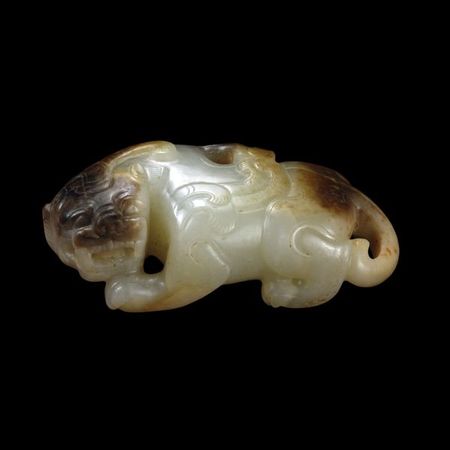Jade figure of a crouching animal. China, Han dynasty (206 BC- AD 220)
Jade figure of a crouching animal. China, Han dynasty (206 BC- AD 220). Height: 2.800 cm. Length: 8.000 cm. On loan from a private collection OA 26:7. The British Museum. © 2003 Private Collection © Trustees of the British Museum
The people of the Han dynasty (206 BC - AD 220) believed that animals, both real and mythical, provided contact with the spirit world. Some might avert evil, bring good luck or appear when auspicious events were about to occur. Emperors and officials lined the approaches to their tombs with large carved stone animals that would enlist supernatural help to protect them in the Afterlife. Animal carvings in jade were believed to be especially powerful, as the material was associated with the immortals because of its translucency, colour and indestructible quality.
The carver of this piece has taken advantage of a narrow oval pebble to show a creature prowling, menacing the viewer, with its horned head low near the ground. The general character of the artefact comes close to, but is not identical with that of a bixie found with four other creatures at Xianyang near present-day Xi'an, and dated to the Han period. These were discovered near Weiling, the tomb of the Han emperor Yuandi (reigned 48-33 BC). Like these other pieces, this jade is a product of Han interest in the strange and miraculous creatures that they deemed to be portents and omens.
J. Rawson, Chinese jade: from the Neolith (London, The British Museum Press, 1995, reprinted 2002)

/https%3A%2F%2Fprofilepics.canalblog.com%2Fprofilepics%2F1%2F0%2F100183.jpg)
/https%3A%2F%2Fstorage.canalblog.com%2F03%2F02%2F119589%2F96711876_o.jpg)
/https%3A%2F%2Fstorage.canalblog.com%2F11%2F31%2F119589%2F94773502_o.jpg)
/https%3A%2F%2Fstorage.canalblog.com%2F20%2F83%2F119589%2F94772815_o.jpg)
/https%3A%2F%2Fstorage.canalblog.com%2F26%2F72%2F119589%2F75604929_o.jpg)
/https%3A%2F%2Fstorage.canalblog.com%2F59%2F60%2F119589%2F26458628_o.jpg)



/http%3A%2F%2Fstorage.canalblog.com%2F21%2F70%2F119589%2F129465814_o.jpg)
/http%3A%2F%2Fstorage.canalblog.com%2F56%2F10%2F119589%2F129336591_o.jpg)
/http%3A%2F%2Fstorage.canalblog.com%2F48%2F50%2F119589%2F129336487_o.jpg)
/http%3A%2F%2Fstorage.canalblog.com%2F85%2F01%2F119589%2F129336407_o.jpg)